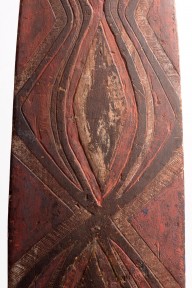Lot #44 - An Extraordinary and Important Ceremonial Shield
-
Auction House:Mossgreen
-
Sale Name:The Marc & Elena Pinto Collection
-
Sale Date:20 May 2015 ~ 6.30pm
-
Lot #:44
-
Lot Description:An Extraordinary and Important Ceremonial Shield
Kimberley Region, Western Australia (early twentieth century)
carved wood and natural earth pigments
124 cm high -
Provenance:Private Collection, Western Australia (1950s); Private Collection, Queensland; The Marc and Elena Pinto Collection, Perth
-
Notes:There are more varieties of Aboriginal shields in Western Australia than are found in other parts of the continent. Distinct forms are found in the north and central Kimberley and the Dampierland Peninsula, while along the 80-Mile Beach are found the so-called ÔLa GrangeÕ shields, made of heavy hardwood and engraved with meticulously executed interlocking-key designs. In the Pilbara, and south to the Gascoyne- Murchison region, are found shields of lighter wood with panels of zigzags engraved on the face. When these latter shields have the zigzags confined to three panels they are generally known as wunda shields. On the edge of the western deserts, hardwood shields also occur sometimes with simple engraving - concentric lozenge motifs and sets of fine zigzag engraved lines being common also. As would be expected the earliest shields found in collections generally conform stylistically with others from the same area. In the early 20th century however there appeared a liberating from the strictures of traditional conformity. More shields were decorated in ways that indicate that the individual artists/craftsmen who made them, were exercising a flexibility, hitherto unknown. It should be noted that these shields were still functional objects - made for combat, traditional exchange and ceremonial purposes and not created for the tourist or art market. This beautiful shield appears to be a north Kimberley shield of the type called iwinu or jinyen. Made from the soft wood of the Bean tree (kandiwal) or the Red Kapok tree (wurndala) the shields may be a simple length of tree trunk with a recessed handle excavated into it at midpoint and round in section, or a more carefully made wider shield, oval in plan and with a biconvex section. The handle is generally raised above the body of the shield with space for the fingers hollowed out beneath the grip. North Kimberley shields were used primarily as defensive weapons when fighting with clubs, rather than in spear fights where agility was all-important and the spearthrower was used to deflect flying shafts. Generally theses shields bore minimum decoration - usually a few bands of paint - red, black or white. However some shields are decorated with quite abstract blocks of colour. The great student of Aboriginal art, D.S. Davidson illustrates a shield from the Forrest River area with triangular panels of black, red, and white pigment in the mid-section that separates what appears to be the head and tail of a dugong1. More recently shields from this area were profusely decorated by painting naturalistic images - bush scenes, ceremonial activity, hunting and fishing or figures of cosmological beings were common themes. From the 1970s with the growth of tourism and an expanding art market shields are more often decorated with engraved rather than painted motifs of a similar nature. One of the finest of Kimberley shields, this example is unusual in the elegant low relief carving and the careful painting of the series of conjoined elliptical, or ÔshuttleÕ forms, that are embraced by sets of concentric bands on both front and back. In many ways the decoration is reminiscent of the complex thread-cross palga dance ornaments carried by dancers in the north Kimberley. The fine patina and worn grip indicate that this piece had seen a lot of handling prior to collection. Kim Akerman 1. D.S. Davidson, 1937. A Preliminary Consideration of Aboriginal Australian Decorative Art. American Philosophical Society. Philadelphia. P.37, Fig. 25b.
-
Estimate:A$30,000 - 50,000
-
Realised Price:
-
Category:Tribal
This Sale has been held and this item is no longer available. Details are provided for information purposes only.















